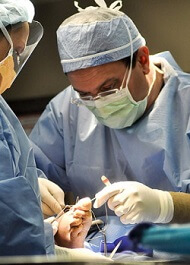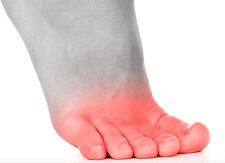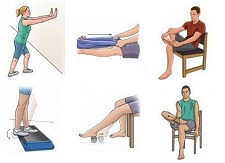- Home
- Common Foot Problems
- Bunions
- Recovering From Surgery
Bunion Surgery Recovery
Written By: Chloe Wilson BSc(Hons) Physiotherapy
Reviewed By: FPE Medical Review Board
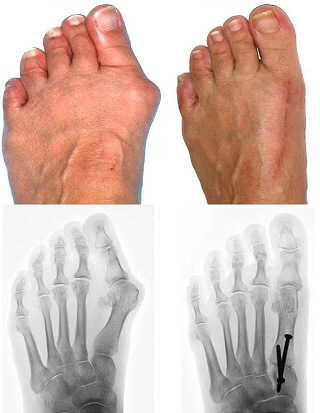
After bunion surgery recovery usually takes around three to six months. 85% of bunion operations are successful with minimal side effects.
In order to get the best results from bunion surgery, it really helps to understand what happens during surgery and what to expect during the following days, weeks and months.
Here we will look at typical bunion surgery recovery including how long it takes to return to activities and key points for ensuring a successful outcome. We will also look at possible complications following bunion operations and when you should contact your doctor.
Every bunion surgery is slightly different so the recovery process can vary slightly, always follow the advice of your doctor.
If you want to know more about bunions, aka hallux valgus, including the causes, symptoms and treatment options, visit the bunions overview section.
The Day of The Operation
Bunion surgery is normally done as an out-patient, meaning you arrive at hospital a couple of hours before your surgery and are discharged later that day.
Surgery usually takes up to an hour and afterwards, you will be taken to the recovery room and monitored until your heart rate, blood pressure and breathing as well as the sensation and circulation in your foot are back to normal. This takes slightly longer if you have a general anaesthetic rather than an ankle block.
Your foot will be bandaged to hold the toes in the correct position with dressings in place to cover the wound and the stitches, or occasionally your foot may be in a cast. You will be given a special shoe to wear when you are walking for the first few weeks of bunion surgery recovery. These are nice and wide so there is no pressure through the foot, and often have a special wedge under the heel to help you not to put any weight through the front of your foot during the initial phase of bunion surgery recovery.
You can find out more about what happens during the operation in the bunion surgery section.
You may be given
crutches or a stick to help you get around – your physical therapist
will teach you how to use these and how to safely get up and down the
stairs before you are discharged.
#CommissionEarned from Amazon on qualifying purchases
First 6 Weeks After Bunion Surgery
During the first couple of weeks, the most important parts of bunion surgery recovery are to keep your foot elevated, the wound and dressing dry and to keep walking to a minimum. These are the things you should do to ensure you make a good bunion surgery recovery:
1. Elevation
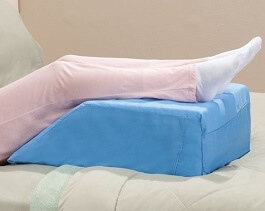
You should keep your foot elevated as much as possible for at least two weeks after bunion surgery. This helps to reduce the swelling and pain. You will find that if you have your foot down for too long, it will start to throb, swell and become more painful.
You want to keep it elevated higher than your groin to allow the excess fluid to drain away. Do make sure your knee is supported at the same time else it will become sore and stiff. Any time you are sitting down, you should have your foot elevated. Failure to do this will adversely affect your bunion surgery recovery time.
You can simply prop your leg up on pillows, but people often prefer a Leg Elevation Pillow made of memory foam which offer contoured support and tend to keep your leg in a better position. Find Out More >
2. Walking
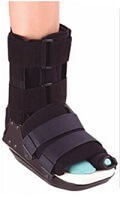
Walking should be kept to a minimum in the early stages of bunion surgery recovery as foot swelling increases when the foot is down. When walking, you should always wear a specially designed Off-Loading Shoe or boot that is shaped so that all the pressure goes through your heel as you walk and protects the front of the foot. Find Out More >
Keep using your crutches for as long as your surgeon advises, normally around two weeks, but sometimes up to six weeks depending on the type of operation. After this, you can gradually increase how much weight you put through your foot and how far you walk as part of the bunion surgery recovery process.
3. Regular Ice
Using ice packs regularly the first few weeks after bunion surgery helps to reduce swelling and pain. The ice pack should be carefully positioned so as not to put pressure through the operated area. Visit the ice treatment section to find out how to use ice safely and effectively to aid bunion surgery recovery.
4. Dressings & Wound Care
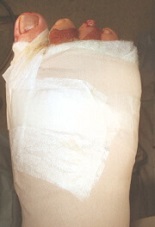
It is really important that the dressings remain in place and are kept dry for the first couple of weeks after bunion surgery until the stitches are removed. This is to allow the wound to heal properly and the toes to heal in the correct position.
The wound and dressings must be kept completely dry so take care with washing. You can place a waterproof plastic bag over the dressing and tape it with waterproof tape when bathing, use a specially design Waterproof Leg Cover or stick to strip washes.
Stitches and dressings are usually removed after two weeks and after this it is ok to get the foot wet. However, sometimes you will need to continue with a cast or dressings to hold to toes in place for a few more weeks during bunion surgery recovery depending on the type of operation.
5. Medication
Your doctor will prescribed you with appropriate medications to help with your bunion surgery recovery. It is important to take your painkillers regularly to stay on top of the pain. You may also be prescribed antibiotics to help reduce the risk of infection. Some medications such as aspirin can increase the risk of bleeding so always talk to your doctor about medications and follow their advice.
6. Exercises
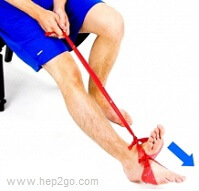
Exercises are a really important part of bunion surgery recovery. You may be able to start them straight away or you may need to wait a few weeks depending on the type of surgery.
Your physical therapist will give you exercises to do to help improve the movement, flexibility and strength of your foot and toes. It is really important to stick to your exercise programme after bunion surgery, otherwise you are at risk of developing stiffness in the toe.
7. Driving
It will depend on the type of surgery and what sort of car you drive as to when you can start driving again following a bunion operation. If you have an automatic car where you operate the pedals with your unaffected foot, you can usually start driving after a couple of weeks. Otherwise, you need to wait until you can put full weight through your foot and can perform an emergency stop, which usually takes 4-8 weeks.
You should inform your insurance company about your operation before driving again to make sure your insurance is valid.
2-6 Months After Bunion Surgery
Full bunion surgery recovery often takes around six months but mild pain and swelling can last for up to a year.
1. Returning to Work
It will depend what your occupation is as to when you can return to work following a bunion operation. If you have a sedentary job where you can keep your foot elevated, you may be able to return at around six weeks if your bunion surgery recovery is going well. If your job is more physical, it may be three months until you can return – follow the advice of your surgeon.
2. What Footwear Is Best?
Once the dressing are removed you can start to wear normal shoes. Choose ones that are soft and wide so there is no pressure through the operated area to allow the bones and soft tissues to heal in the correct position. You will need to wear these for several months. You must not wear high heels, narrow fitting or pointed shoes for at least six months after bunion surgery otherwise there is a risk of developing problems with your bunion surgery recovery. It may help to wear a protector sleeve or toe spacers to help protect the area.
3. Returning To Sports
You can now gradually increase your activity levels and most people return to sports between 3-6 months after bunion surgery.
Bunion Surgery Recovery Key Points
Successful bunion surgery recovery is largely down to how well you follow your surgeon’s advice. If you try and do too much too soon, or start wearing inappropriate shoes too quickly, problems may arise.
To ensure successful bunion surgery recovery:
- Keep the foot elevated as much as possible
- Keep dressings in place and the area dry until the stitches are removed - use a waterproof leg protector when showering
- Keep walking to a minimum, wearing your special off-loader shoe and keeping all the weight through your heel (using crutches if necessary) for the first few weeks
- Do not wear high heels for at least six months
- Follow your exercise programme
Complications From Bunion Surgery
Complications are rare with 85% of people reporting successful bunion surgery recovery. Possible complications after bunion surgery include:
- Blood Clot: With any surgery, there is a small risk of a
blood clot developing, such as a DVT (deep vein thrombosis) or PE
(pulmonary embolus) after bunion surgery. Always contact your doctor immediately if you
develop pain, redness or swelling in your calf or shortness of breath
- Recurrence of Bunions: This is extremely rare if you follow all of the post-op bunion surgery recovery advice
- Infections: Occasionally the area may become infected requiring antibiotics or in rare cases further surgery
- Scarring: Occasionally the scar can cause irritation
- Stiffness: Stiffness can develop in the toe and foot if you do not follow your exercise programme. If you have had a fusion, the joint will be permanently stiff
- Metalwork: Occasionally, problems can develop from the metalwork such as screws or wires moving slightly. If this happens, they may need to be removed
- Numbness or Tingling: Occasionally there may be some damage to some of the small nerves in the foot during bunion surgery which causes numbness or pins and needles. This usually settles in a few months into bunion surgery recovery but in some cases may be permanent
- Poor Healing: The bones may fail to heal properly especially if you are a smoker. You should refrain from smoking until the bones are fully healed or else your bunion surgery recovery may be affected
When To See Your Doctor
Always contact your doctor immediately if any of the following things happen during bunion surgery recovery:
- The dressings get wet or come undone – don’t try and change them yourself
- Bleeding or oozing appears on the dressings
- Fever
- Warmth, redness, bleeding or excessive swelling in the foot
- Pain or swelling in the lower leg
- Increase in pain levels
- Numbness or pins and needles in the foot
What Else Can Help?
Bunion surgery recovery will vary from person to person so listen to your doctor, rather than comparing yourself with anyone else. You can find out lots more about bunions including the causes, symptoms, treatment options and different types of operation in the following sections:
- Bunion Guide: An overview of bunions including common causes
- Symptoms: Includes both classic and less common symptoms
- Treatment Options: Best treatments including orthotics and exercises
- Surgery: Different surgical options available
- Top Products: Things that can help with prevention or recovery from surgery
Page Last Updated: 01/25/24
Next Review Due: 01/25/26
